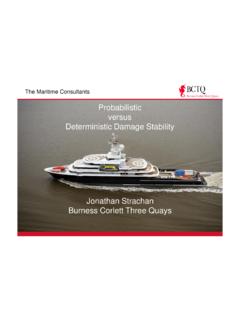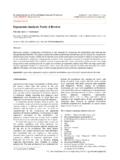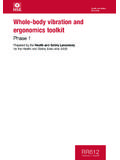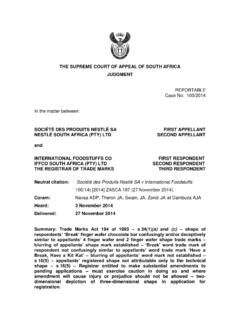Transcription of THE PRACTICAL DIFFICULTIES OF ASSESSING THE ... …
1 Design and Operation of Passenger Ships, 20-21 November 2013, London 2013: The Royal Institution of Naval Architects THE PRACTICAL DIFFICULTIES OF ASSESSING THE STABILITY OF CRUISE SHIPS D. J. Ridden, Burness Corlett Three Quays Ltd, United Kingdom SUMMARY There has been significant growth in the number and size of cruise ships, due to the popularity of cruising holidays, with a resulting increase in passenger numbers. This growth in passenger numbers has occurred at the same time as regulatory changes to ensure adequate margins of stability in intact and damaged conditions are provided. However, the statutory requirements for confirming the accuracy and reliability of the lightship properties remain largely unchanged and do not reflect the increased risk presented by ever larger passenger ships. Cruise ship operators regularly seek to improve both the appearance of and the amenities on their vessels, resulting in potential weight changes.
2 This then results in the requirement to verify the lightship properties. It is becoming increasingly popular to perform lightship surveys when the vessel is in service, ensuring that if an inclining experiment is required, this can take place at the end of a refit. However, it is also becoming more common to undertake inclining experiments with the ship in service. 1. INTRODUCTION It is a requirement of the International Convention for the Safety of Life at Sea, Part B, Reg. 20, that: On completion of loading of the ship and prior to its departure, the master shall determine the ship s trim and stability and also ascertain and record that the ship is in compliance with stability criteria in relevant regulations. To assist the ships staff in providing reliable results, the lightship data of the ship must first be determined.
3 In accordance with SOLAS Chapter II-1 Regulation 5 all passenger ships are to undergo lightweight surveys at 5 yearly intervals. The maximum permissible deviation from the previously approved lightship data requires an inclining experiment if the lightship weight or longitudinal centre of gravity deviated from the previously approved values by more than 2% and 1% respectively. Burness Corlett Three Quays Ltd has been involved in inclining experiments and lightweight surveys on many different ship types. BCTQ personnel have been involved in overseeing shipyards conducting these experiments and surveys. We also regularly organise this work on vessels in service, particularly cruise ships. This results in our personnel travelling throughout the world, surveying and inclining vessels in the most unexpected locations.
4 Should these surveys not be performed, the authorities may rescind the passenger ship safety certificate, resulting in the vessel being unable to operate. It is important to note that although these surveys and experiments are conducted in accordance with statutory requirements, and are regularly witnessed by appropriate class or flag surveyors, BCTQ can only request assistance from the ships staff/shipyards to enable a successful outcome to be achieved. Procedures are submitted to the authorities for approval prior to the start of the survey and even though specific requirements are identified and agreed, these may not always be fulfilled. 2. STATUTORY REQUIREMENTS In Annex 1 of the Intact Stability (IS) Code, clear guidance is given on how to prepare for and conduct an inclining experiment.
5 This guidance includes a comment on the number of slack tanks that are acceptable and at what level slack tanks should be. However this is very difficult to achieve, particularly when the ship is in service. Very often, most fuel and fresh water tanks are slack, if only to achieve an acceptable trim and fluid KG. Also, on older vessels, the ships engineers are generally reluctant to press tanks full in case of potential damage to the tank structure. 3. DEFINITIONS A few definitions applicable to all ships are required to explain the technical terms. Deadweight is the difference between the lightship weight and the displacement of a ship at the load line corresponding to the assigned freeboard and is the weight of all consumables, stores, cargo, crew and/or passengers and effects and all other liquids on board.
6 Deepest subdivision load line is the waterline that corresponds to the greatest draught permitted by the subdivision requirements which are applicable. Displacement is the overall weight of the ship the sum of the lightship weight and deadweight at the assigned freeboard. Gross Tonnage (GT) is a measure of the total enclosed volume of a ship. Design and Operation of Passenger Ships, 20-21 November 2013, London 2013: The Royal Institution of Naval Architects KG fluid is the vertical centre of gravity above the baseline, corrected for the effects of free surface moments. LBP is the Length between Perpendiculars. Lightship weight is defined as the weight of a ship complete in all respects, but without consumables, stores, cargo, crew or passengers and effects, and without any liquids on board except that machinery and piping fluids, such as lubricants and hydraulics are at operating levels.
7 Lightship weight survey is a detailed survey of the vessel which is undertaken to identify and record all deadweight items, thereby allowing the weight of the lightship and the position of its longitudinal and transverse centres of gravity to be derived. Inclining experiment is a test which is used to derive the vertical centre of gravity of the lightship. Passenger ship is a ship that carries more than 12 passengers. 4. DATABASE With a database of more than 30 cruise ships that includes over 120 lightweight surveys and in excess of 25 inclining experiments, BCTQ has significant experience with this type of ship. The range of sizes of these ships is also significant with the smallest having an LBP of approx. 67m, GT of approx.
8 2100 and the largest having an LBP of approx. 300m and GT of approx. 150,000 (see Fig. 1). Similarly the age profile also varies significantly with the oldest vessels having being built in the 1970 s. This age profile is significant in various ways. For example, the older ships, in general, tend to be smaller but have relatively large open deck spaces with superstructures constructed from steel, thereby allowing inclining weights to be used. However, suitable locations for pendulums can be difficult to arrange, resulting in pendulums and troughs having to be arranged in awkward locations such as engine casings, storerooms or even in swimming pools. Fig. 1 Cruise Ship database The larger, newer vessels offer different problems.
9 The drive for larger cruise ships has resulted in most of these vessels being built with aluminium superstructures and although they have significant open deck space, the strength of these decks is, in general, not sufficient to take the load imposed by the inclining weights that are required to heel the ship sufficiently without adequate reinforcement. This reinforcement is often not PRACTICAL and therefore an alternative method to heel the ship during an inclining experiment is very often required. One alternative method involves the transfer of fluids. 5. HYDROSTATIC DATA The accuracy of any lightweight survey and inclining experiment will depend upon the available data tank calibrations and the vessels hydrostatic properties.
10 More modern ships are generally defined electronically, using one of a number of naval architecture software packages. However for the older vessels, it is not unusual for the available information to be limited to tank capacity tables and even keel hydrostatic data. Worse still, hydrostatic curves on paper that is over 40 years old and which has been reprinted on numerous occasions, resulting in very suspect data. 6. LIGHTSHIP WEIGHT SURVEYS As previously stated, lightship weight surveys are conducted at 5 yearly intervals in accordance with statutory requirements. However it is becoming quite common to conduct these surveys at more regular intervals. The reasons for this are varied and may be due to discrepancies between the calculated and observed draughts onboard caused by erroneous results from preceding surveys, unrecorded weight changes, preparatory work in advance of planned changes to the ship at forthcoming refits or the ship being sold or internally transferred.






